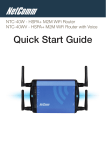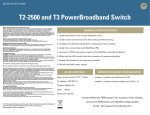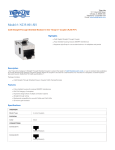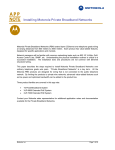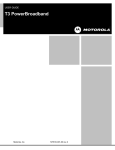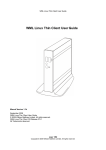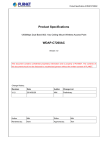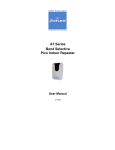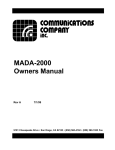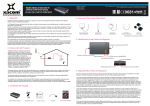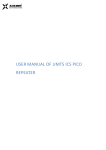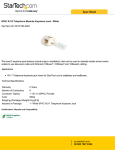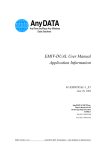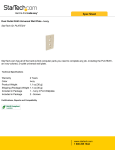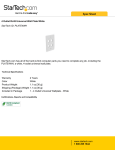Download Motorola MC-802 User's Manual
Transcript
Installing Motorola MC-802 Wireless WallPlate The MC-802 Wireless WallPlate is a new addition to the PowerBroadband product family. This application note details specific topologies and best practices used for the installation of the Wireless WallPlate. To set the proper context, we’ll start with a short introduction of the T3 PowerBroadband system. Key concepts used throughout the document are covered in Appendix A. Best practice recommendations include a limited site survey procedure to determine installation density. T3 PowerBroadband System The T3 system from Motorola is designed primarily for hospitality, but useful in any high density MDU type installation. The T3 PowerBroadband Switch is installed in the central phone room of a hotel or MDU, where it is cross connected onto the existing telephone wiring. The centrally installed T3 PowerBroadband Switch has 25 ports for downstream CPEs, and 2 x GigE uplink ports. Two different types of remote CPEs are supported. The CPEs are installed in a hotel guest room or any RJ11 jack within the MDU. The CPEs are designed as a wall plate form factor, and draw operating power over the same telephone wire pair as broadband backhaul. Due to the form factor, the name “WallPlate” is used to describe the CPE. m2 WallPlate The m2 WallPlate is a managed, Ethernet-only device. It has two 10/100Mb Ethernet ports to connect access devices. 802.1Q VLANs and QoS can be managed throughout the system, from the 25-port switch to each wall plate port. MC-802 Wireless WallPlate The Wireless WallPlate is just what it sounds like. It is a line-powered WallPlate with an integrated 802.11b/g radio. The Wireless WallPlate has the same two 10/100Mb Ethernet ports as the m2 WallPlate. All configuration, status and statistics for the Wireless WallPlate are provided by the centrally installed T3 Switch. Key features: • Line power up to 600 meters* for the m2 WallPlate, and 300 meters for the MC-802 Wireless WallPlate. Line power is transparent to and compatible with analog telephone service on the same wire • One wire pair • Optimized for IPTV and other advanced networking *600m is the limit of line power. If using an optional external power supply, T3 will deliver broadband up to 1500m The T3 system is comprised of the following components. In addition to the primary products listed, filters are required for extra telephones that share the same wire pair. Motorola, Inc Page 1 of 12 • • • Name: Motorola P/N: Model: T3 PowerBroadband Switch, RoHS 558975-001-00 45225 • • • Name: Motorola P/N: Model: m2 Ethernet WallPlate, RoHS 549478-001-00 45101 • • • Name: Motorola P/N: Model: MC-802 Wireless WallPlate, RoHS 557925-001-00 45010 T3 PowerBroadband Switch and m2/MC-802 WallPlates TABLE OF CONTENTS Installation Routine.............................................................................................3 Example Lite-Site Survey ...................................................................................5 Example Installation ...........................................................................................7 Example One: RoomLoss = 20dB.............................................................................................. 7 Example Two: RoomLoss = 15dB.............................................................................................. 8 Appendix A ........................................................................................................10 Motorola, Inc Page 2 of 12 Installation Routine The goal of the installation can be stated relative to received signal strength (RSSI): • • -70dBm signal strength or better in every room Maximum of three co-channel cells within the carrier detect range Perfect non-overlapping cell coverage is impossible to achieve. Read Appendix A for a description of the carrier detect range and its effect on media access. The network architect can control three variables when deciding where and how to install the Wireless WallPlate network. Each variable has a different degree of effect on the overall network performance. • Physical placement is an important determinant of success. Because of the fast installation routine, WallPlate placement is easy to adjust onsite during the installation. • Channel assignment is used to create overlapping coverage cells and reduce the cochannel cell overlaps. In most countries, channels 1 – 11 are available; where only channels 1, 6, 11 are non-overlapping for 802.11g modulation. • Transmit power can be adjusted to fine-tune the signal strength and reduce some cochannel interference. The WallPlates can be adjusted in 1dB increments from 14dBm to 1dBm. NOTE: Transmit power alone will not overcome an installation with too great a density. Full Site Survey The goal of any wireless site survey covers two key purposes: • Determine the number of APs required for adequate RSSI into each hotel guest room. • Determine where and how to backhaul and power the AP installed in the hotel corridor. Because the hotel guest is in the room, and not in the hallway, co-channel interference between hallway-installed APs is usually not considered during a site survey. The focus is on pumping enough power into the rooms to connect the hotel guest. When APs are installed in the hotel corridor, mistakes are nearly impossible to correct. Adding an additional AP to cover a weak area of the hotel is extremely difficult. Typical corrective action usually involves a higher gain antenna. This is often ineffective if poor coverage is due to obstructions or multi-path reflections. Thus, an extensive and expensive site survey is required. Lite-Site Survey With the Wireless WallPlate, the possible install locations include each room in the hotel. Because of the fast installation, corrective action is very easy to execute if additional WallPlates are required. Thus the site survey can be done quickly or not at all, with adjustments made during the installation time. Since the same construction material is used throughout the property, a complete room to room site survey is unnecessary. Motorola, Inc Page 3 of 12 The goal of the WallPlate site survey is to determine the average RSSI loss through one room/wall combination Provisioning the WallPlates • Order the number of WallPlates according to the RSSI loss through one room/wall. If the floor material is the same as the walls e.g. concrete, then the vertical loss will be similar (usually +3dB to +6dB). Offset the installation with each floor so that WallPlates are not stacked vertically above one another. • Order 5% extra WallPlates for coverage in non-standard areas of the hotel; such as rooms blocked by an elevator shaft. During the installation, if coverage holes exist, plug the hole by installing an extra WallPlate. Once the typical RSSI loss through a hotel is determined, site surveys at similar hotels become unnecessary as the same plan can be used repeatedly. WallPlate Density Chart Based on the RSSI loss from one room/wall, order the indicated number of WallPlates, plus 5% margin. RSSI loss is… >30dB >20dB and <30dB >10dB and <20dB <10dB Motorola, Inc Horizontal WP density One every three rooms One every four rooms One every four to six rooms One every eight rooms Vertical WP offset Install offset one room Install offset two rooms Install offset three rooms Install offset four rooms Page 4 of 12 Example Lite-Site Survey Many hotels are built with mirror image rooms to speed the construction time. The example below was taken from a real 250 room hotel constructed of concrete block on all interior and exterior walls. TV/desk TV/desk TV/desk TV/desk TV/desk TV/desk TV/desk TV/desk TV/desk TV/desk TV/desk TV/desk TV/desk TV/desk Layout of the hotel rooms Measured RSSI a A B D C Motorola, Inc Page 5 of 12 Location Transmitter RSSI -28dBm Loss 42dB A a B C D -32dBm -60dBm -55dBm -83dBm -80dBm 4dB 32dB 27dB 55dB 52dB Note Antenna to air conversion loss. Measured at 1m using integrated Intel Pro2200B/G in Dell Laptop. Same room, with AP mounted 12” from floor Down one floor One room over Across the hall, over one room Two rooms over Note some interesting results: 1. We can predict the measured RSSI three rooms over would be -105dBm, well below the carrier detect range. 2. RSSI loss is approximately 25dB per room/wall. Vertical loss is 32dB. Based on the RSSI loss from A to B, this installation would require one WallPlate for every four rooms. Motorola, Inc Page 6 of 12 Example Installation E x a m p l e O n e : Ro o m L o s s = 2 0 d B Hotels generally use dense wall material to reduce audible noise from one room to another. Concrete is a common material. 20 to 25dB RF loss can be measured through concrete hotel walls, but actual results may vary. The worst case would be a client PC sitting approximately midway between two WallPlates on the same floor. From this location, the client would be within the carrier detect range of multiple WallPlates. Rm 205 B Ch-1 D Ch-1 H Ch11 -60dBm -70dBm F Ch11 -70dBm client Rm 201 Rm 203 Rm 205 Rm 207 Rm 209 Rm 211 Rm 213 Rm 202 Rm 204 Rm 206 Rm 208 Rm 210 Rm 212 Rm 214 -112dBm -70dBm G Ch-6 E Ch-6 A Ch11 -112dBm I Ch-1 C Ch-6 Anticipated RSSI in Room 205 • • All WPs at maximum Tx power Connected to WallPlate H in room 105 on channel 11 Will See AP … A B C D E F G H I Motorola, Inc At RSSI … -112dBm -60dBm -112dBm -70dBm -70dBm -70dBm -112dBm -60dBm -112dBm On Channel … 11 1 6 1 6 11 6 11 1 Co-Channel No No No No No Yes No Yes No Notes Outside Range Different channel Outside Range Different channel Different channel In range, same ch Outside Range Connected Outside Range Page 7 of 12 RF Media Access The client wireless driver will connect with the WallPlate that has the strongest RSSI. Regardless of which WallPlate is selected by the client driver, the co-channel interference will be one other WallPlate, very low co-channel interference and well within the bandwidth of the RF medium. Redundancy Five total WallPlates are within -70dBm of the client. Thus, if one WallPlate fails, the client will always maintain a high datarate connection to the network. E x a m p l e T w o : Ro o m L o s s = 1 5 d B Using the same installation density, let’s look at the resulting RSSI loss when the loss per wall/room combination is 15dBm and the floor loss is 5dB greater than the horizontal. B Ch-1 D Ch-1 H Ch11 -50dBm -60dBm -60dBm F Ch11 client Rm 201 Rm 203 Rm 205 Rm 207 Rm 209 Rm 211 Rm 213 Rm 202 Rm 204 Rm 206 Rm 208 Rm 210 Rm 212 Rm 214 -95dBm G Ch-6 A Ch11 -60dBm E Ch-6 -95dBm I Ch-1 C Ch-6 Note that WallPlates A, G, C, and I are all approximately -95dBm, right at the edge of the carrier detect range of -94dBm. Additionally, WPs two floors up will also appear within the carrier detect range. Motorola, Inc Page 8 of 12 Transmit Power Adjustment In this case, we reduce the transmit power of all WallPlates by 6dBm. Note the resulting RSSI changes: WallPlates A, G, C and I fall below the carrier detect range and will not present cochannel interference with the client. B Ch-1 D Ch-1 H Ch11 -56dBm -66dBm -66dBm F Ch11 client Rm 201 Rm 203 Rm 205 Rm 207 Rm 209 Rm 211 Rm 213 Rm 202 Rm 204 Rm 206 Rm 208 Rm 210 Rm 212 Rm 214 -101dBm G Ch-6 A Ch11 Motorola, Inc -66dBm E Ch-6 -101dBm I Ch-1 C Ch-6 Page 9 of 12 A pp en di x A Media Access Control 802.11 wireless devices are half-duplex; meaning they cannot transmit and receive simultaneously. Access to the media is controlled by carrier detect media access - listening on the specified frequency, and transmitting in a time when no other signal is present. Using carrier detect many devices can share the same RF medium. Adding CTS/RTS further increases the number of co-channel devices; although CTS/RTS itself reduces the total bandwidth available to the client. Carrier Detect Range Carrier detect media access operates within the maximum distance that a signal will be received above the noise floor of a neighboring device. This is the carrier detect range. When laying out the network topology, it is important to factor the carrier detect range. For the Wireless WallPlate, the carrier detect range is -94dBm, the sensitivity level of the receiver. Note that the carrier detect range is not a physical distance; however, some attempt is made in this document to correlate physical distances to the important RF domain since we all live in the real world. Pathloss Pathloss is defined as the ratio of transmit to received power, normally expressed in dB. It can be measured by subtracting the receive signal strength in dBm from the transmit signal power in dBm. Pathloss calculations are always one-way; from a transmitter to a receiver. In theory, the return path should be the same, but does vary. It is not uncommon to see asymmetrical pathloss. It is desirable for a client device to have a low pathloss to more than one WallPlate. The client driver normally associates with the AP having the strongest signal (lowest pathloss). Because of the material used in hotel construction, pathloss is difficult to mathematically calculate. It must be measured. While this implies a comprehensive site survey; in fact, some basic assumptions can be made from a relatively simple site survey using only the received signal strength (RSSI). Signal Loss in Material bed RoomLoss in dB = (Loss through wall material) + (Loss in free space in room) TV/desk Most RF pathloss discussions focus on the losses in free space, without consideration for the attenuation through different wall material. In fact, the attenuation that occurs in a 27cm concrete block wall is nearly equal to the signal loss over 6 meters in free space! (using the formula Pathloss in dB = (Loss at 1 Meter) + α * 10 * LOG(Distance in meters) + Xσ). To simplify this process; we can combine the loss through free space in one room with the loss through one wall material and arrive at a value that can be applied cumulatively through multiple rooms. bed bath Motorola, Inc Page 10 of 12 The material used in walls and floors can vary from one property to another. For example, different chemical formulations of concrete can cause loss variations up to 5dB. The following chart is based on RF engineering studies and can be used as a general guide. Material Concrete block Red Brick Drywall Loss (dB) 15 - 20 15 – 25 3–6 + Room (dB) 6 6 6 = RoomLoss (dB) 21 – 26 21 – 31 9 - 15 Tools Many software site survey tools are readily available for a charge or free. Using the RoomLoss method; it is only required to use a software tool that displays all visible BSS (AP MAC address) and their associated RSSI and channel. NetStumbler is one such tool. Cisco CB21 PCMCIA cards also provide this information using the included software suite. While many manufacturers may use the same wireless radio chipset, implementations can vary quite a bit. RF sensitivity on the board, antenna design and antenna cable losses all vary from one laptop model to another. Since we are primarily interested in the signal delta (its loss factor), the actual RSSI reading is not quite as important. Validate the laptop sensitivity before beginning the installation, using this procedure: 1. Set the Wireless WallPlate in site survey mode by loading the special software, or turn on the WallPlate and set the transmit power to 14dBm 2. Align the WallPlate in a vertical position with the flared tabs on the top and bottom 3. Place the laptop at 1meter away from the WallPlate AP on the same vertical height. The RSSI of the WallPlate should be between -26dBm and -30dBm. Redundancy It is desirable for an installation to provide adequate signal coverage with the loss of any single AP. Passive redundancy, or rather redundancy by design, requires an installation in which every location receives adequate signal levels from two or more APs. This must be balanced with the potential for co-channel interference. Co-Channel Interference Because of the media access method described above, each AP or client will reduce the bandwidth available to any other AP or client on the same channel. This co-channel interference is expected and predicted by carrier detection and media access. While we cannot control where a client will be located, we can control the co-channel interference between any two WallPlates during the installation. Selecting the installation density to control co-channel interference is the point of this document. Multi-Path Reflections RF signals are like rolling a football; they take a funny bounce. Sometimes, a strong signal can be received in one location; while movement of only a few feet can result in much lower signal. Each WallPlate AP has two antennas with receive diversity. Simply stated, the signal from any other transmitting device is received by both antennas, and the stronger signal is passed to the wireless driver. Motorola, Inc Page 11 of 12 Deviations and Exceptions As always, there will be exceptions. For example, a hotel may not use the same material between all rooms. It could be that concrete is used every four or five rooms; with drywall between the concrete walls. This can be very good for proper signal attenuation, but some upfront thinking is required. In general, using the RoomLoss method with an Install Time adjustment will lead to faster or no site surveys. Look for creative ways to use the fast installation of the Wireless WallPlate to simplify your processes and provide a better network. Motorola, Inc Page 12 of 12












